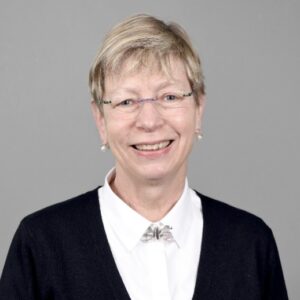
Dr. Betsy Fahlman is a professor of art history at Arizona State University, where she has taught since 1988. A specialist in American Art, her interests include public art, American modernism, the New Deal, industrial archeology, and the art history of Arizona. Since 2016, she has been Adjunct Curator of American Art at the Phoenix Art Museum. Dr. Fahlman is a founding member of the Board of Western Spirit: Scottsdale’s Museum of the West.
Q: Your most recent book and the accompanying exhibition you curated—which was on view at Phoenix Art Museum from November 7, 2021 to March 6, 2022—is Landscapes of Extraction: The Art of Mining in the American West. Have you always been interested in industrial themes in art?
A: When I was working on my PhD at the University of Delaware, I came across the Society for Industrial Archaeology. My first book, John Ferguson Weir: The Labor of Art, discusses industrial themes in his work as well as his career as the first director of the Yale School of the Fine Arts. More than just industrial themes, though, wherever I have lived, I’ve delved into the art and culture of that region, the art of place. When I lived in Pennsylvania, I worked on Charles Demuth. Here in Arizona, I’ve done work on a number of Western and Arizona themes: the art of mining, civic art, and women artists of the West, to name three.
Q: What would you say is your greatest contribution to Western Spirit?
A: Helping the museum achieve broader representation—more women artists in particular, but other constituencies as well. Bringing the Fran and Ed Elliott Collection to Western Spirit places the museum at the forefront of shedding light on many women whose artistry and achievements have not been widely appreciated. After meeting the Elliotts and learning that the family wanted the collection kept together, my husband and I went there and packed everything up—more than 300 hundred works—in three days. There was art all over the house, under rugs, on tables, under beds. And there were books they had illustrated, and china and jigsaw puzzles that featured the artists’ works. In the end, there was a feeling of discovery, and that it was a good deed to have brought these works to a public collection. I also brought a collection of the work of Marjorie Thomas and the archive of Jesse Benton Evans, both painters the Elliotts collected, to Western Spirit. The Santa Fe Railroad amassed the first corporate collection of art in the United States and regularly purchased art by women. In fact, there are more works by Evans than any other artist in the Santa Fe Railroad collection. The collection and archive will allow students and scholars to dive into the careers of some remarkable artists.
Q: Are you working on anything new at the moment?
A: I am. I’m currently on sabbatical and have finished several chapters in my book on Arizona’s early women artists. I have co-curated an exhibition at the Harwood, William Herbert “Buck” Dunton: A Mainer Goes West, which features some great paintings by the “cowboy artist” of the Taos Society of Artists, including a wonderful “new woman-cowgirl” painting of Margo Phillips Beutler from the Fred Jones Jr. Museum of art at the University of Oklahoma. I’m also in the planning stages of shows on Catharine Critcher, the only woman in the Taos Society, and the paintings of Edith Hamlin, who was married to Maynard Dixon at the end of his life. I am fascinated by the many women who have been “lost and found:” reclaiming their lives and work is part of my mission.
Q: What drew women artists to Arizona?
A: For the women who came to Arizona during the first half of the twentieth century, the state proved to be a transformative experience. These women strong, intrepid, adventurous, and talented women who were inspired by the state’s arid desert expanses, the rugged mountains and canyons of the Colorado Plateau, and the state’s Indigenous peoples. The community was widely dispersed, and it was hard to put people together. But the women who came to the area were well-trained. What attracted them was the beauty of the landscape—and the freedom. Freedom from Victorian strictures; freedom to ride and roam, to make art and make a living at it. Women could have more authority here. Remember, women were voting in Wyoming and Utah decades before the federal right was enshrined.
Q: What comes to mind first when you think about Western Spirit?
A: What I love about Western Spirit is what I love about all museums—the stuff, the objects, and how, through curatorial work, they can tell different stories and present new challenges. It is important that Western Spirit isn’t just an art institution. The Abe Hays Collection, for example, is a powerful historical tool with its spurs, saddles. Thinking about the exhibitions the museum has mounted, I have especially loved the strong single-artist shows: Maynard Dixon, Edward Curtis, and Lone Wolf.
Q: How do you envision Western Spirit’s future as the museum enters its next phase?
A: Now that Western Spirit is becoming a museum that has its own outstanding collections, we will have to get into the grant writing business and begin to create our own exhibitions—with accompanying scholarship and books that we generate ourselves—that travel to other institutions. It will be a big step up.
